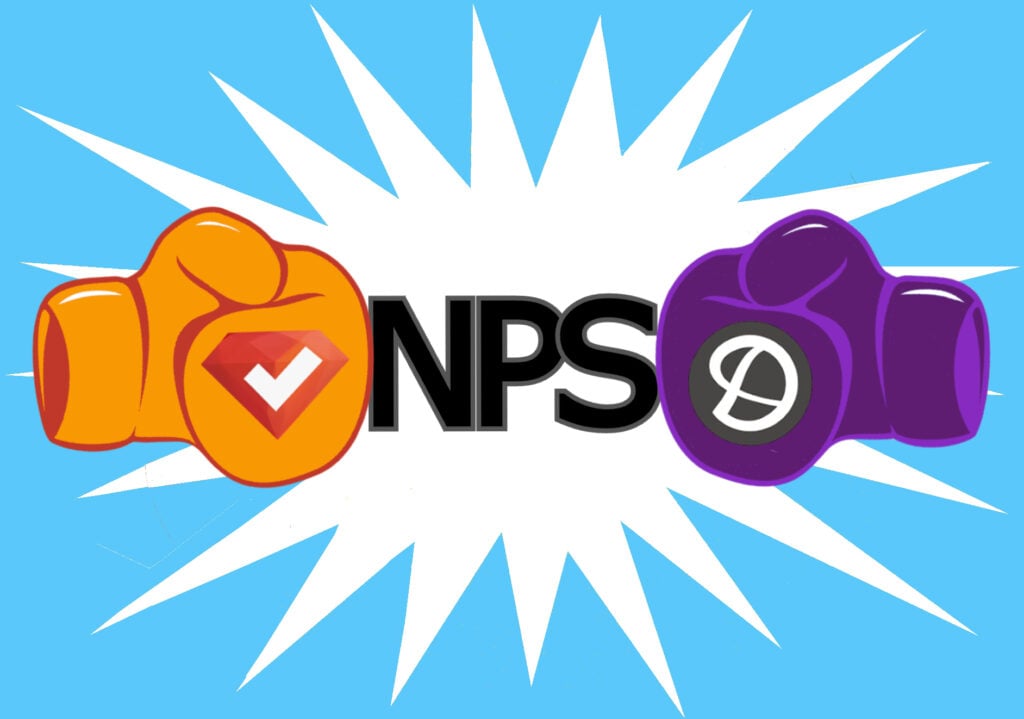The term psychographic is derived from the word psyche (meaning the human spirit or mind) and the word graphic (meaning a representative picture of something). So, psychographic segmentation is a research methodology that divides people into groups using psychological characteristics. Criteria will typically include one or more of the following: Personality, lifestyle, social status, activities, interests, values, opinions, attitudes, and aspirations. When it comes to surveys, researchers will typically use a psychographic survey, a demographic survey, or a combination of both.
Create your FREE Psychographic Survey, Poll, or Questionnaire now!
Psychographic Segmentations vs Demographic Segmentation
Demographic data tells you about a person, using data like age, race, gender, education or income level, occupation, and so on. On the other hand, psychographic data tells you about how a person feels, what their goals are, what they value, and so on.

Psychographic Segmentation and the Buyer Persona
While demographic data is usually easier to obtain, psychographic data is often far more valuable for marketers and researchers. Consider a marketing agency that is developing a new exercise product aimed at male millennials. Demographic data will help them zero in on that age group and gender, while psychographic data will help them understand if they would be interested in the product itself. That’s why a combination of demographic and psychographic data is a win-win.
Here’s a look at how using both types of data, a company can come up with a buyer persona for who they call “Millennial Mark. ” A buyer persona is a fictional profile of a potential customer that might include their age, career, hobbies, challenges, etc.

As you can see, “Millennial Mark” is a great candidate for this new exercise equipment. Mark has the ability to afford it and cares about staying in shape, especially since he feels his “youth is slipping away.” Plus, with no children, he has the time to work out. Finally, he is ready to settle down and may think he needs to have a great body in order to find the right partner.
Benefits of Psychographic Segmentation for Surveys
Here are five key benefits of using psychographic segmentation on your marketing or research surveys.
- Gaining a better understanding of someone’s needs, wants, worries, goals, challenges, and more.
- Gaining the ability to communicate with them on a more personal and emotional level.
- Customizing your marketing messaging from general features and benefits to how a product or service will fit into and improve someone’s life.
- Learning how and why someone uses your product or service.
- Learning why someone may not be interested in your product or service and how you can improve it.
Five Psychographic Segmentation Variables
Psychographic segmentation has become increasingly important as more people continue to define themselves based on their beliefs, activities, hobbies, and so on. The emergence of social media has been a large impetus for this, allowing us to easily connect with like-minded people with shared interests. Currently, there are five psychographic segmentation variables that researchers have identified.
1. Personality
Many people make a lot of their buying decisions based on their personality. An easy way to remember what psychologists consider the “Big 5 Personality Traits” is the acronym OCEAN, which stands for the following:
- Openness to new ideas. These people are imaginative and creative and welcome change.
- Conscientiousness toward others. These people often plan ahead and take other people into consideration.
- Extroversion level. Those who are extroverts are outgoing and enjoy the company of others, while those who are introverts prefer more alone time.
- Agreeableness with others. These people are cooperative and kind, whereas other people may be untrusting and disagreeable.
- Neuroticism or level of emotional stability. Highly neurotic people will tend to be moody or anxious while, at the other end of the spectrum, are those who are relaxed and more stable emotionally.
Psychographic segmentation in marketing uses these traits to develop product messaging for their target audience.
2. Lifestyle
Depending on a person’s lifestyle, they are likely to have different needs, wants, goals, and challenges. The lifestyle of a serial dater, for example, will likely be very different from that of a soccer mom, just as the lifestyle of a Yoga enthusiast may be different from that of a thrillseeker.
Habits also factor into a person’s lifestyle. Do they wake up and grab Starbucks every morning, or wake up and hit the gym? These types of habits help marketers to design menus for those coffee drinkers or create apparel for those early exercisers. Loyalty clubs, for example, are often highly based on a person’s habits and have given rise to the “lifestyle brand,” which is a product or service that is an important part of someone’s life.
3. Social Status
A person’s social status, which is typically related to their income, will influence their purchase habits. This usually factors heavily when a marketing is determining their marketing mix (pricing, messaging, and so on). Commonly used classes include upper class, upper middle class, middle class, working class, and lower income.
Of course, some people will make purchases that fall outside of their “class” because an item is desirable and makes some sort of statement. For example, someone who buys a new BMW because it is a status symbol, even though it is out of their price range
4. Attitudes
Attitudes are often formed based on a person’s cultural background and upbringing, but this can of course change over time. An example may be whether they have a positive or negative attitude, or it could be more complicated, like whether they have trust or distrust in politicians. To determine people’s attitudes, many researchers use a Likert scale survey to ask people to rate characteristics on a graded scale “not at all important” to “extremely important.”
5. Activities, Interests, and Opinions (AIO)
A person’s activities, interests, and opinions, or AIO, says a lot about them. And for marketers, a lot about how to attract them.
- Activities are focused on people’s daily routines and/or hobbies. A person who bicycles to work every day and plays golf on the weekends will likely have different purchasing patterns from someone who drives to work and binge watches Netflix on the weekend.
- Interests can have some overlap with activities (e.g., someone may list gardening as an interest, but this is also an activity). A better example of an interest would be someone who enjoys coffee. They probably wouldn’t consider this an activity, but it’s something they enjoy. For example, millennials became crazy for coffee yet craved variety, leading to “coffee of the month” subscription clubs.
- Opinions can be held on any number of things, from the social to the political. Marketers aren’t usually in the business of changing minds, but they do like to know how strongly people feel on certain topics in order to inform their brand messaging. For example, they may survey consumers to find out how much they care about sustainability; if a clear majority highly value this, the brand may want to highlight that their product is eco-friendly.
How is Psychographic Information Gathered?
Online surveys are the most cost-effective and efficient way to collect psychographic information about your target audience. Plus, because psychographic surveys can get into some personal or sensitive questions, surveys can offer anonymity that in-person interviews cannot. Here’s an example of a psychographic survey created with SurveyLegend. You’ll see that it begins with some qualifying demographic questions before launching into psychographic questions.
NOTE: The example below is live, give it a try!
Sometimes, surveys are conducted to get a quick response from a large population. Then, in order to delve deeper with the most qualified respondents, a more involved survey is conducted amongst this smaller subset. Or, these individuals may be contacts for a follow-up in-person interview or focus group.
Psychographic Segmentation in Marketing: Examples
Here are six brands that market themselves using psychographic segmentation. It’s highly likely that these brands conducted surveys to find out who their customer base is, what they value, and what motivates them in order to craft messaging that would speak to them.
- Nike, “Just Do It”. A tagline that resonates with athletes, the brand promises to give people the tools they need to perform better.
- Dollar Shave Club, “Shave Time, Shave Money”. At the time of its inception, shaving clubs were not a thing. This tagline hit home for both money-conscious consumers and those who value convenience.
- BMW, “The Ultimate Driving Machine”. This tagline touches on people’s desire to drive a status symbol once they’ve “arrived” in their career and financially.
- Rothy’s, “Reduce Your Carbon Footprint In Style”. This niche brand of footwear knows that its customers care about the environment. So, they employ a zero-waste manufacturing process and let their customers know.
- Taco Bell, “Think Outside the Bun”. This slogan was designed to tap into fast foodies who were tired of hamburger joints.
- Harley-Davidson, “Free By Birth, Rebel By Choice”. Harley knows their audience, and it shows. This tagline appeals to bikers who value American brands and who love the freedom of riding.
Conclusion
Psychographic segmentation is a great way for researchers to learn about people and society. It’s also a powerful tool for marketers needing to better understand their customers. Psychographic segmentation in marketing can uncover a whole host of information about consumers: their personality, lifestyle, social status, activities, interests, values, opinions, attitudes, and aspirations. It’s a marketers best friend when it comes to messaging!
Ready to create your psychographic survey? Start now with SurveyLegend! Our surveys are easy to create, render beautifully on any device, and allow you to add images to your surveys to make them more engaging. They’re highly secure, allow for anonymity, and provide awesome analytics.
Have you conducted psychographic surveys in the past? Do you use them in conjunction with demographic questions? Sound off in the comments!
Create your FREE Psychographic Survey, Poll, or Questionnaire now!
Frequently Asked Questions (FAQs)
Psychographic segmentation groups people into categories based on psychological characteristics such as personality, lifestyle, social status, activities, interests, values, opinions, attitudes, and aspirations.
Demographic information looks at hard data (age, race, gender, etc) while psychographic information looks at soft data (feelings, opinions, attitudes, etc). Demographic data is quantitative while psychographic data is qualitative.
The most common way to collect psychographic information is through an online survey, although in-person interviews and focus groups are also popular.
Psychographic data helps researchers better understand people and helps marketers inform their marketing strategy. When combined with demographic data, it can be a very powerful tool.





